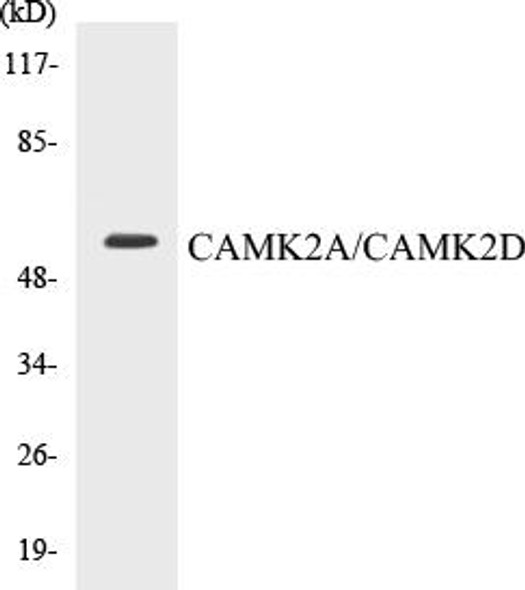Description
CAMK2A/CAMK2B/CAMK2D Antibody (PACO05424)
The CAMK2A/CAMK2B/CAMK2D Polyclonal Antibody (PACO05424) is a valuable tool for researchers studying calcium/calmodulin-dependent protein kinases (CAMK2s) involved in various cellular processes. This antibody, produced in rabbits, is highly specific and reactive with human samples, making it an ideal choice for Western blot applications.CAMK2s are a family of serine/threonine kinases that play essential roles in cell signaling, neuronal plasticity, and muscle contraction. They are activated by calcium/calmodulin and are involved in regulating diverse cellular functions.
The CAMK2A, CAMK2B, and CAMK2D isoforms are particularly important in neuronal signaling, synaptic plasticity, and memory formation.By targeting CAMK2A, CAMK2B, and CAMK2D proteins, this antibody allows for the detection and analysis of these kinases in various cell types, providing crucial insights into their roles in physiological and pathological processes. Its specificity and reliability make it a valuable tool for research in neuroscience, cell biology, and drug development aimed at targeting CAMK2s for therapeutic purposes.
| Antibody Name: | CAMK2A/CAMK2B/CAMK2D Antibody (PACO05424) |
| Antibody SKU: | PACO05424 |
| Size: | 50ug |
| Host Species: | Rabbit |
| Tested Applications: | ELISA, WB, IHC |
| Recommended Dilutions: | ELISA:1:5000, WB:1:500-1:2000, IHC:1:100-1:300 |
| Species Reactivity: | Human, Mouse, Rat |
| Immunogen: | Synthesized peptide derived from human CaMKII β / γ / delta around the non-phosphorylation site of T287. |
| Form: | Liquid |
| Storage Buffer: | Liquid in PBS containing 50% glycerol, 0.5% BSA and 0.02% sodium azide. |
| Purification Method: | The antibody was affinity-purified from rabbit antiserum by affinity-chromatography using epitope-specific immunogen. |
| Clonality: | Polyclonal |
| Isotype: | IgG |
| Conjugate: | Non-conjugated |
| Synonyms: | CAMK2B; CAM2; CAMK2; CAMKB; Calcium/calmodulin-dependent protein kinase type II subunit β; CaM kinase II subunit β; CaMK-II subunit β; CAMK2G; CAMK; CAMK-II; CAMKG; Calcium/calmodulin-dependent protein kinase type II subunit γ; |
| UniProt Protein Function: | CAMK2B: a widely expressed protein kinase of the calcium/calmodulin-dependent protein kinase (CAMK) group. Functions autonomously after Ca2+/calmodulin-binding and autophosphorylation. Involved in dendritic spine and synapse formation, neuronal plasticity and regulation of sarcoplasmic reticulum Ca2+ transport in skeletal muscle. In neurons, plays an essential structural role in the reorganization of the actin cytoskeleton during plasticity by binding and bundling actin filaments in a kinase-independent manner. This structural function is required for correct targeting of CaMK2A, which acts downstream of NMDAR to promote dendritic spine and synapse formation and maintain synaptic plasticity which enables long-term potentiation (LTP) and hippocampus-dependent learning. In developing hippocampal neurons, promotes arborization of the dendritic tree and in mature neurons, promotes dendritic remodeling. Participates in the modulation of skeletal muscle function in response to exercise. In slow-twitch muscles, is involved in regulation of sarcoplasmic reticulum (SR) Ca2+ transport and in fast-twitch muscle participates in the control of Ca2+ release from the SR through phosphorylation of triadin, a ryanodine receptor-coupling factor, and phospholamban, an endogenous inhibitor of SERCA2. The holoenzyme is composed of 4 different chains: alpha (CAMK2A), beta (CAMK2B), gamma (CAMK2G), and delta (CAMK2D). The different isoforms assemble into homo- or heteromultimeric holoenzymes composed of 12 subunits with two hexameric rings stacked one on top of the other. Interacts with SYNGAP1 and CAMK2N2. Interacts with MPDZ. Expressed in adult and fetal brain. Expression is slightly lower in fetal brain. Expressed in skeletal muscle and induced during exercise. Eight isoforms of the human protein are produced by alternative splicing |
| UniProt Protein Details: | Protein type:EC 2.7.11.17; Kinase, protein; Protein kinase, CAMK; Protein kinase, Ser/Thr (non-receptor); CAMK group; CAMK2 family Chromosomal Location of Human Ortholog: 7p14.3-p14.1 Cellular Component: nucleoplasm; sarcoplasmic reticulum membrane; plasma membrane; microtubule organizing center; spindle midzone; cytosol Molecular Function:calmodulin binding; protein homodimerization activity; calmodulin-dependent protein kinase activity; actin binding; ATP binding Biological Process: regulation of long-term neuronal synaptic plasticity; regulation of skeletal muscle adaptation; protein amino acid autophosphorylation; cytokine and chemokine mediated signaling pathway; regulation of calcium ion transport; signal transduction; protein amino acid phosphorylation; regulation of synaptic transmission, cholinergic; inhibitory G-protein coupled receptor phosphorylation; synaptic transmission; peptidyl-serine phosphorylation; response to cadmium ion; calcium ion transport; regulation of synapse structural plasticity; neuromuscular process controlling balance; G1/S transition of mitotic cell cycle |
| NCBI Summary: | The product of this gene belongs to the serine/threonine protein kinase family and to the Ca(2+)/calmodulin-dependent protein kinase subfamily. Calcium signaling is crucial for several aspects of plasticity at glutamatergic synapses. In mammalian cells, the enzyme is composed of four different chains: alpha, beta, gamma, and delta. The product of this gene is a beta chain. It is possible that distinct isoforms of this chain have different cellular localizations and interact differently with calmodulin. Alternative splicing results in multiple transcript variants. [provided by RefSeq, May 2014] |
| UniProt Code: | Q13554 |
| NCBI GenInfo Identifier: | 334302890 |
| NCBI Gene ID: | 816 |
| NCBI Accession: | Q13554.3 |
| UniProt Secondary Accession: | Q13554,O95437, O95438, O95599, Q9UGH7, A4D2K0, A4D2K1 A4D2K2, A4D2K3, A4D2K4, A4D2K5, A4D2K6, |
| UniProt Related Accession: | Q13554 |
| Molecular Weight: | 664 |
| NCBI Full Name: | Calcium/calmodulin-dependent protein kinase type II subunit beta |
| NCBI Synonym Full Names: | calcium/calmodulin-dependent protein kinase II beta |
| NCBI Official Symbol: | CAMK2B |
| NCBI Official Synonym Symbols: | CAM2; CAMK2; CAMKB |
| NCBI Protein Information: | calcium/calmodulin-dependent protein kinase type II subunit beta; caMK-II subunit beta; CaM-kinase II beta chain; CaM kinase II beta subunit; proline rich calmodulin-dependent protein kinase |
| UniProt Protein Name: | Calcium/calmodulin-dependent protein kinase type II subunit beta |
| Protein Family: | 6-oxocamphor hydrolase |
| UniProt Gene Name: | CAMK2B |
| UniProt Entry Name: | KCC2B_HUMAN |











